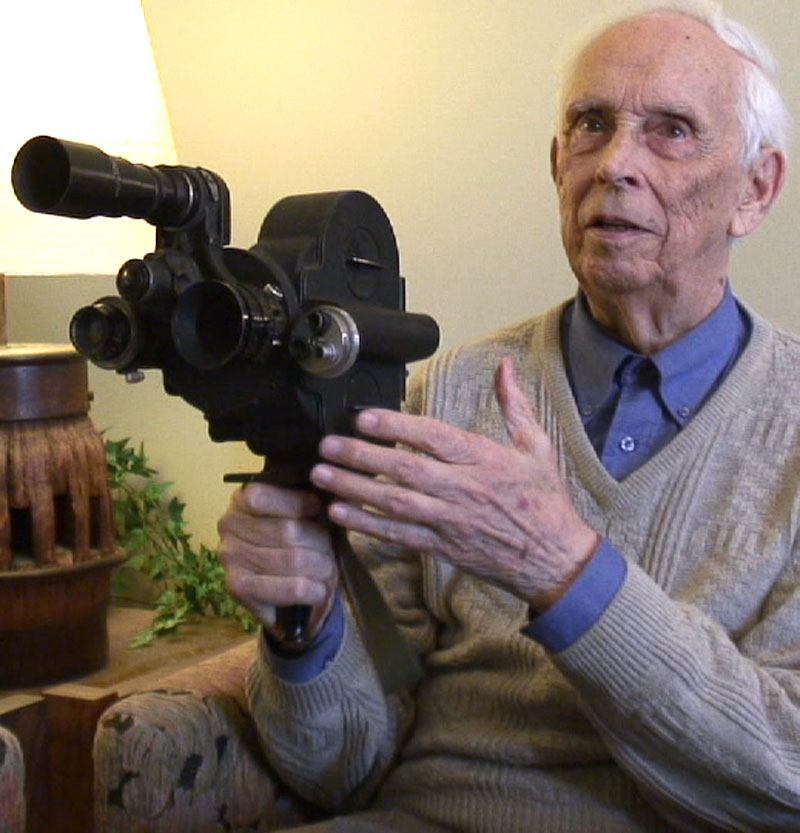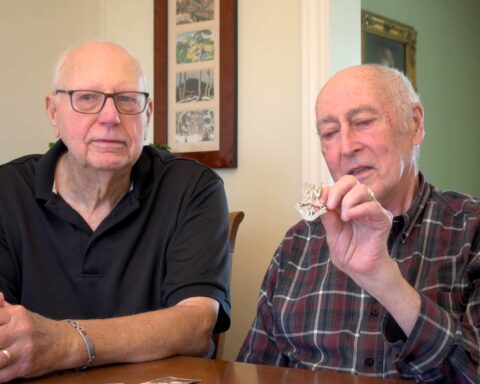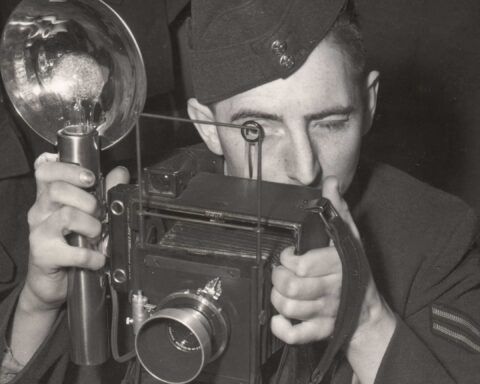For the first time, all 110 photographic albums, known as the “Army numerical” series at Library & Archives Canada, are now available online to the general public.
The series of albums consist of contact sheets printed from the original b&w negatives, of Canadian Army photographs shot during World War II, 1941-1946.
For many years I had been aware of these albums while working as a Film Conservator at Library & Archives Canada (LAC). At the time, these albums were some of the most in demand finding aids for WWII images stored at LAC.
Known to staff as the ‘pizza boxes’, the Army numerical albums were stored in acid free custom made containers. Even though stored in ideal conditions, the albums were beginning to show their age; brittle and dry, the contact sheets were warping, and some of the adhesive keeping them glued to the pages was drying out.
One day while doing research for a client in Italy, I came across one of the albums online, and that is when I learned that there were only 7 of the complete 110 albums available online. What I also found buried in the albums images, were photographs of members of the Canadian Army Film & Photo Unit. Some of which I had never seen before. I wondered, “What other photographic ‘gems’ must be hidden away in the other 103 albums?”
During a series of discussions with LAC staff, a proposal was submitted to access all remaining 103 albums, and have them scanned using LAC’s Book2Net self-service book scanner located in their ‘DigiLab’. The Digilab is specifically equipped with Epson flatbed Photo Scanners used to scan photographic prints and negatives.
One of the challenges we encountered was how to adapt a piece of equipment created specifically for scanning bound books with lots of text, to scanning old photographic albums with very little text. A process was eventually devised by removing the metal screws that bound the albums, and then systematically scanning each of the albums pages using the handy foot-switch to initiate a scan leaving the hands free to prepare for the next scan. Performing several test runs, we were able to fine-tune the process resulting in successfully scanning one album in approximately 15 minutes.
Not without its share of error messages, and false starts, the whole project was eventually completed over a period of several months. All this was being done while staff continued to serve other clients. It wasn’t until the beginning of February 2020 that all remaining 103 albums were finally completed.
In total, “110 albums (8441 photographs) on 8327 album pages : b&w. ca. 62,000 photographs : b&w negatives” were scanned and converted into 103 separate .PDF files, along with OCR (optical character recognition), to allow each of the .pdf albums to be text searchable.
Even though the Covid-19 virus had begun to cripple the LAC’s ability to service the general public, staff were still able to prepare every one of the albums for eventual upload to the LAC database.
UPDATED LINK – Today, the albums now serve a global audience via an easily accessible digital resource in the form of Library & Archives online database. All 110 albums, are listed here by visiting this link which will take you to the Library & Archives Canada website HERE . Or cut and paste the following into your preferred browser;
(https://recherche-collection-search.bac-lac.gc.ca/eng/Home/Result?q_type_1=q&q_1=army%20numerical%20albums&SEARCH_TYPE=SEARCH_BASIC&)
“Scope and content
The sub-series, consisting of photographs identified as “Army numerical”, which unlike the majority of other Army, RCN or RCAF imagery, was not assigned an alphabetic prefix. Printed copies of the negatives exist within 110 albums (printed as contact sheets with caption information), originally part of DND FA19. This is basically an inventory of Army photographs from mainly, but not exclusively, the Second World War (see below for details). The photographs are arranged numerically, chronologically and by region. Volumes 1-58 depict operations in the United Kingdom; volumes 59-73 are designated generally as DND; volumes 74-107 show North West Europe; the last three albums of the 110-volume series are titled: Secret 1; Secret 2; and Secret 3. United Kingdom albums include such subjects as: Army training; troop arrivals and departures; invasion exercises; hospitals; Royal visits; Dieppe survivors; Investitures at Buckingham Palace; mail ships; War Brides; funerals; mining in Wales; Canadian Forestry Corp in Scotland; sports meets; etc. DND albums consist of mainly Canadian troops in North Africa, Canada and Australia, Sicily and Italy. North West Europe albums are comprised of mainly Canadian troops in Belgium, France, Holland, and Germany. The many subjects depicted in this sub-series include: Canadians in action; Invasion Operations; refugee evacuations; CWACs; Victory Loans; tanks; mine-clearing school; POWs; Landing Beaches; German prisoners; Royals inspecting troops; Canadian General Hospitals; Nursing Sisters; cemeteries; mines; snipers; Amphibious Operations; Dieppe Raid; Red Cross; sweeping the shipping channel; Russian Generals; evacuation of Belgium children to Switzerland; D-Day Landings; Churchill visit; pipeline construction; liberation of concentration camp; surrender of Nazis to Foulkes; official delivery of surrender terms; liberations of Utrecht and The Hague; Montgomery meets Rokossovsky; peace celebrations; disarming program; bomb damage seen from air; Food and Surrender Conference; Victory Parades; Germans removing minefields; Canadian repatriation; Canadian War Art exhibition; etc.”
I want to thank the following people for allowing me the opportunity to serve alongside staff at Library & Archives to provide such a valuable Canadian resource;
Karine Gélinas (Project Manager, Public Services Branch); Satya Miller (Metadata Control Officer, Public Services Branch); Jean Matheson (Consultation and Reference Officer, Public Services Branch); Lynn Lafontaine (Consultation and Reference Officer, Public Services Branch); Alexander Comber (Military Archivist for Library and Archives).
Please contact Library & Archives Canada regarding any of the content within the WWII albums. As well, feel free in contacting me should you have questions or wish to retain my services in acquiring access to any of the b&w negatives that make up the many thousands of images within the WWII albums.
© 2020 Dale Gervais
















Fantastic work. Thankyou! I am restoring a Sherman Firefly which saw service with 21st CAR in 1945… photos of which in service will greatly assist.
Hi Tim – glad to hear the Numericals are helping out with your project – keep me posted on the progress! Dale
Hi Dale. Found your website looking for photographer Donald Grant as I was searching for pictures from the Pas-de-Calais area. These albums are amazing and open up a new source for me, on photography in 1944-1945 northwestern Europe. Thank you very much!
Hi Arthur, the Army Numericals are a real treasure and a great photographic resource for researching Canada’s military involvement during WWII. Keep me posted on any progress you make that you would like to share on this website! 🙂
Dale, my grandfather Len Thompson was a photographer for Canada during World War II. A cousin suggested I look at the National War Museum, but I am an American and live far from Ottawa. However, the National war museum website led me to the library and archives Canada website which led me to you and back to library and archives Canada! Thanks to this page I believe I just found a picture of Len hanging his laundry on the Siegfried line! I am so amazed. It looks like there are likely other pictures of him in these albums as well. While I was hoping to find photographs he took, finding photographs of him himself is incredibly exciting. Also, these albums are helpful to me in better understanding the context and importance and reasons behind his long separation from my grandmother. Thank you so very, very much.
Thank you very much for contacting me, Angela. It is always really special to receive email from family members of the CFPU! I sent you some additional information regarding CFPU cine cameraman, L.E. Thompson with reference’s to additional Army Album images found of him in the field during WWII.
Looking for Alfred Stark in Westminster Regiment that fought in Northern Africa against Rommel. My Father enlisted in September 1939 thru the Winnipeg, Manitoba branch. I was wondering if any photos have my Father in them.
Hi – there are images of the Westminster Regiment in Albums 70, 71, 89, 104, and I came across a Pte. Alf Stark of Carlyle, Sask. in Album no. 61, neg 22324. Let me know if any of this helps. Dale
Hello,
I am looking for anything Second World War related to the SDG Highlanders 3 div B company if you have any leads as to where I may find more photos than google searching has gotten me so far?
I have service number etc and lots of documentation on my grandfather however only 1 photograph of him has been found by myself from 1945 Hilversum Netherlands, again any info anyone could help me with is muchly appreciated!!
Hi Kevin – I would suggest you search the online database at Library & Archives Canada and their Army Numericals; https://canadianfilmandphotounit.ca/2020/04/12/library-archives-canada-army-numerical-series-110-albums-now-available-online/ – Dale
Dale – thanks for your immense efforts in getting this work done. The Feb.6 reply to Kevin, above just routes one back to this page – not LAC. Can you provide a URL for LAC which would get one to the top of the 110 albums? Thanks in advance!
Thanks Peter – I ran another search and here is a link that will list all 110 Albums; https://recherche-collection-search.bac-lac.gc.ca/eng/Home/Search?q=army+numericals+album&num=100&start=0&DateBucket=1940-1949&DataSource=Archives%7cFonAndCol – thanks again for bringing this to my attention. Dale.
Hello I have found that some of the Albums like e999917445-u Album 35 UK has no link to the finding aid pdf for who and what is in the photos is there another link for these pdfs?
Hi Tina, thanks for contacting me. Unfortunately there are no readily available captions for albums 1 to 39, with the exception of Album 6. The next time I am at LAC I will ask staff if they are available. Dale
Thank you for letting me know. I am making a searchable index file so I can find SDG Highlanders I am looking for. I am hoping there are some in the UK Photo albums
Dale,
I have contacted you before about photos of the liberation of the Netherlands and especially of Apeldoorn and the surrounding area.
Your scanned photo albums are great, for which I thank you.
That must have been quite a job.
A good friend of mine is 90 years old and has lived in Apeldoorn all his life. He recognizes many things in the photos!!
Thanks again for that!!!
Now I have a question: The Royal Canadian Regiment liberated Apeldoorn in April 1945.
When I look at the link below I see 5 PDF files, but among them I miss the file from May 1945. I am looking for this right now!!
Can you tell me where I can find it or has it been forgotten??
Actually another question: where can I find some files of the “Canadian Graves Registration Units” somewhere on the site?
I know it is a lot of questions, but I will ask anyway!!
Greetings, Wout Jansen (Apeldoorn in the Netherlands)
Hi Wout,
Thanks for contacting me.
I sent you a link with results for the Canadian Graves Registration Units;
https://recherche-collection-search.bac-lac.gc.ca/eng/Home/Search?q=Canadian%20Graves%20Registration%20Units&DataSource=Archives&
Also, it would be best to submit a question to Library & Archives Canada and see if they can locate the May/1945 War Diary for the Royal Canada Regiment;
https://library-archives.canada.ca/eng/services/public/ask-us-question/pages/ask-reference-question.aspx?requesttype=3
All the best! Dale.
Thank you so much for your work! My grandmother is Karen Hermeston and its great to see the articles and photos she took
Hi Ivy – thank you so much for reaching out. It was a pleasure researching and learning more about Sgt. Hermeston so that the families can learn more about this incredible generation of Canadians who served overseas at such a crucial time in our history.
Dale
LAC has recently changed their search engine that powers the Collection search. I must say that it has been terrible-I cannot find anything. The link you give here takes me to Lac but it states that there are “0 Results”. Do you know of another way or a current link that I (and others) can use?
Hi Michael – you are correct – I seem to need to update the link every so often.
Here is the new link to view all Army Albums in one search; https://recherche-collection-search.bac-lac.gc.ca/eng/Home/Result?q_type_1=q&q_1=army%20numerical%20albums&SEARCH_TYPE=SEARCH_BASIC&.
I have updated the link in the article as well. Let me know if you have any further issues.
Dale